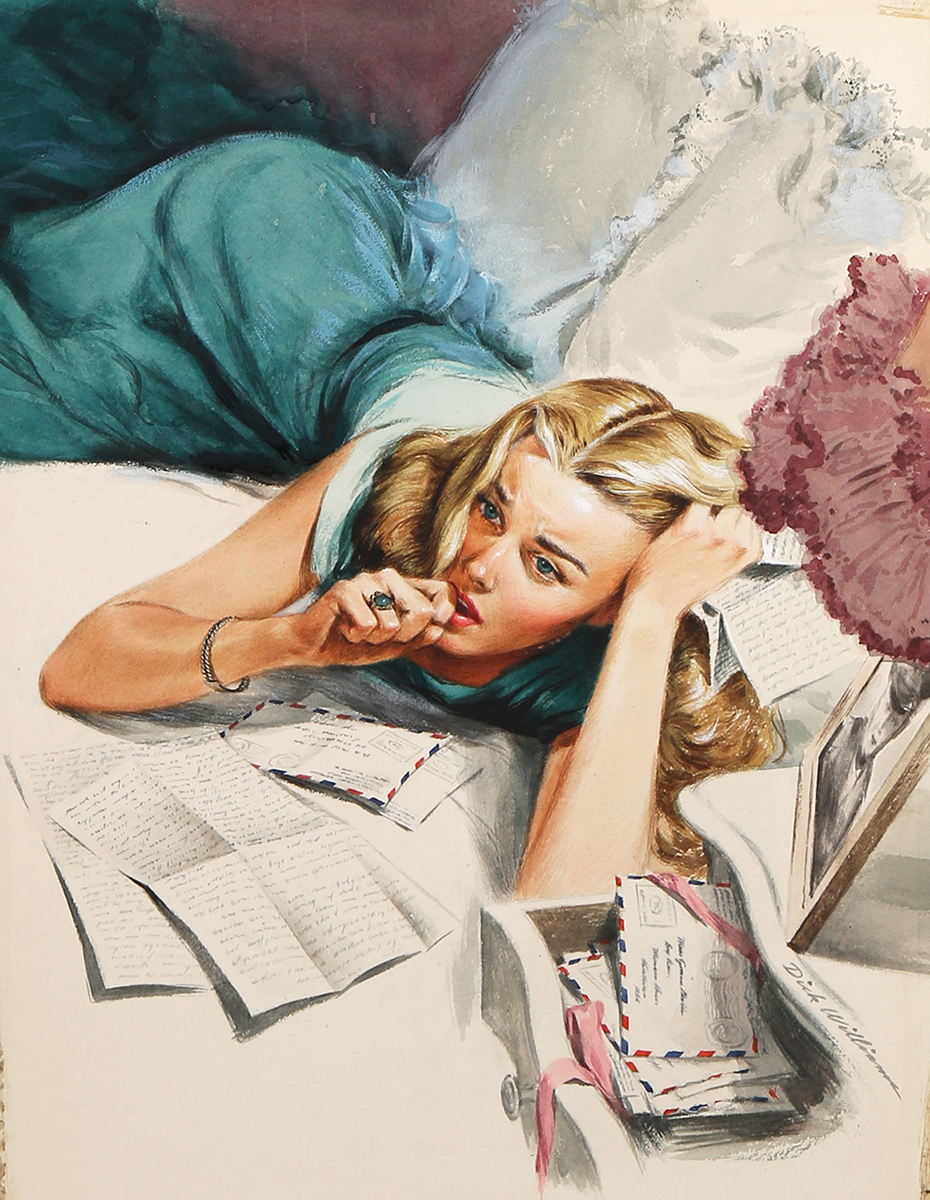
Not So Simple – A Gouache Illustration by Dick Williams
Up for sale is a beautifully rendered and emotionally wrought World War II-era gouache painting by artist and illustrator Dick Williams.
In this published work of art, a young, blonde haired, blue-eyed, girl-next-door lies on her bed surrounded by letters from her beau who is abroad fighting in the war. Distressed, she pulls her fingers through her hair while biting the knuckles on her other hand as she grapples with her feelings of wanting to stay loyal to her G.I. and finding new love on the home front.
Not So Simple was published in the August 25, 1945 issue of Collier’s magazine. It accompanies a short story of the same name by Hope Hale. A copy of this magazine is included in the sale.
This gouache painting was done on illustration board which has been matted and is ready to frame.
Illustration is signed by the artist in the lower right corner.



Richard F. Williams – Illustrator, Portraitist, and Landscape Painter
Richard F. Williams had two successful careers, both in art. He was successful in commercial art for over twenty years . He then gradually switched to fine art, and for more than another twenty years he was known as a portrait artist and painter of landscapes.
Richard was born in Buffalo, New York on March 22, 1908. He lived at home with his parents and one brother, Clifford. Another brother died in infancy. He attended Buffalo schools, and a teacher in the technical high school encouraged him to pursue a careeer in art. He graduated from “The Buffalo School of Fine Arts”.
Richard Williams started his career doing advertising art for the local newspapera. At the age of nineteen, he won first prize for a poster entered in a contest for a local organization.
Richard married Winnifred Decker in 1934, and soon afterwards they moved to Florida. He found work there in advertising art, but it became apparent to him that there was not much future for him there. He decided to move back to New York. He and his wife found an apartment in Manhattan. He soon found work with some of the major advertising agencies, and his career started to take off. He was doing ads in magazines and some illustrations, including a few magazine covers. He signed them “Dick Williams”.
He and his wife moved to the suburbs and started a family. They had two boys before they divorced in 1945. Richard remarried and he and his new wife moved to a house in Crestwood, New York where they lived until he died in 1981.
For the first few years in Crestwood, he commuted to New York every day. He also had a small studio at home. He joined “The Society of Illustrators”.
After Richard and his wife had their first child, a daughter, they decided to build an addition to their house. Richard could now have the kind of studio he had always wanted. It had a skylight, a picture window, and three other windows. It also had two closets and a sink, where he could wash out his brushes. This made it possible for him to work at home, except for going in and out of the city to pick up and deliver his jobs. Every job had a deadline, and as he was a perfectionist, he was often up until dawn in order to meet a deadline.
Richard Williams finally decided to change careers, if he could as he was anxious to see if he could make a living doing fine art. He had always had a strong interest in portraiture, and he tried his hand at landscapes and still lifes, too. He had used ink washes for his commercial art, but now he was using oils. His first portraits were of his wife, his stepson, and his in-laws. He wanted to see if they were good enough to start a new career in earnest, and he decided they were. He then painted a portrait of his mother and entered it in a local art show. When it won first prize, he didn’t hesitate any longer. He hired models, painted their portraits and entered them in art shows throughout Westchester County.
In addition to “The Society of Illustrators, he joined “The Hudson Valley Art Association”, “The American Artists’ Professional League”, “The New Rochelle Art Assiciation”, and “The Mount Vernon Art Association”. His name was beginning to be recognized. Everytime he won a prize, it would be written up in the local paper along with a picture of him with his prize-winning painting.
The first commissions came from neighbors and friends. Then they came through “word of mouth”. He was also receiving commissions from “The Society of “Illustrators”. He was now signing his name “Richard F. Williams” to his work, instead of “Dick Williams”.
He no longer did any commercial work. When he did portraits of children, he preferred using pastels, which were very successful.
Most of his landscapes were done along the Bronx River, which was not far from his house. He painted all seasons along the river. He also painted scenes in Waterford. Connecticut, where his family spent part of their summers.
He showed his work in theater lobbies, hospitals, and local art galleries. Richard Wiliiams became well known in Westchester County. His work output started to decline in the 1970’s, due to the onset of Alzheimer’s disease. His last portrait was of a hospital aide in a day center for Alzheimer patients. He died in a nursing home at the age of 73.




